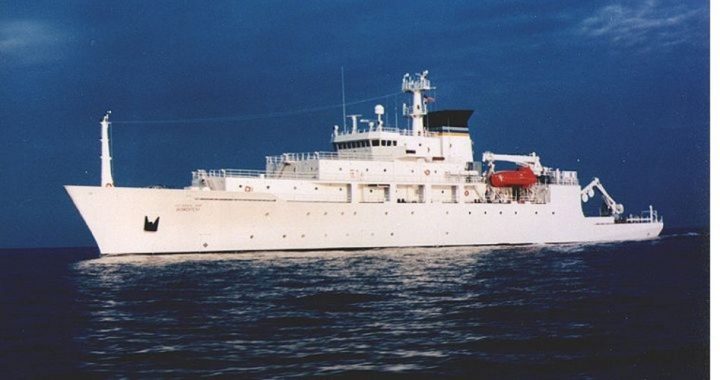
China has agreed to return the U.S. underwater drone that it seized in international waters on December 15, the Pentagon said in a statement two days later. The seizure took place in the South China Sea about 50 miles northwest of the Philippine port at Subic Bay.
“Through direct engagement with Chinese authorities, we have secured an understanding that the Chinese will return the U.U.V. [unmanned underwater vehicle] to the United States,” the New York Times quoted Peter Cook, the Pentagon press secretary, as saying.
Cook said the agreement to release the drone was reached after the United States “registered our objection to China’s unlawful seizure of a U.S. unmanned underwater vehicle operating in international waters in the South China Sea.”
While China agreed to turn over the seized drone, before doing so it accused the United States of reacting too strongly over the incident. “Upon confirming that the device was a U.S. underwater drone, the Chinese side decided to transfer it to the U.S. side in an appropriate manner,” CNN quoted Chinese Defense Ministry spokesman Sr. Col. Yang Yujun as saying. “China and the United States have been communicating about this process. It is inappropriate — and unhelpful for a resolution — that the U.S. has unilaterally hyped up the issue. We express our regret over that.”
The Times also cited a statement made by retired Chinese rear admiral, Yang Yi, who spoke at a conference sponsored by the communist state-run newspaper, the Global Times, who asserted that the Americans had invited the Chinese sailors to take the drone by sailing in the waters close to the Scarborough Shoal, fishing grounds that are claimed by China and the Philippines.
The Americans “deliver these things to our home,” and it would be more than natural for Chinese sailors to seize the drone and examine it, Yang said.
President-elect Donald J. Trump used Twitter to condemn China for its actions on December 17: “China steals United States Navy research drone in international waters — rips it out of water and takes it to China in unprecedented act.”
Later in the day, Trump tweeted, “We should tell China that we don’t want the drone they stole back. — let them keep it!”
The Times cited a Pentagon account of the drone incident, which said that a Chinese Navy vessel had been shadowing the USNS Bowditch (shown), which had stopped to pick up two underwater drones. The Chinese vessel then dispatched a small boat and seized one of the drones before the American sailors could recover it. The Pentagon described the vehicle as an “ocean glider” system used to gather military oceanographic data such as salinity, water temperature, and sound speed.
This account discredits an explanation provided by Chinese Defense Ministry spokesman Yang Yujun on December 17, claiming that a Chinese navy lifeboat discovered an unknown device. “In order to prevent this device from posing a danger to the safe navigation of passing ships and personnel, the Chinese lifeboat adopted a professional and responsible attitude in investigating and verifying the device.”
Considering that the Chinese ship that launched the small boat had been shadowing the Bowditch and could not have failed to see the U.S. sailors retrieve the first drone, the justification offered by the Chinese for picking up the other drone defies credibility.
A more important matter, however, is how the Chinese can justify interfering with the American operation in international waters. This question is partially explained by the ongoing dispute between China and its neighbors around the South China Sea over exactly where the boundaries between each nation’s territorial claims lie.
The Times cited American analysts who observed that the Bowditch’s reported position placed it within 200 miles of the disputed Scarborough Shoal fishing grounds that are claimed by both China and the Philippines.
The Bowditch appeared to be outside the perimeter of the “nine-dash line,” the Times quoted Mira Rapp-Hooper, a senior fellow at the Center for a New American Security. (The “nine dash line” — which originated under the communist nation’s predecessor Republic of China government — was established in 1947 and included the Paracel Islands, the Spratly Islands, the Pratas Islands, and various reefs and shoals in the South China Sea.)
“China has no legal basis to take actions like these on the high seas, but doing so outside Beijing’s ambiguous claim line is particularly egregious and will make the incident especially hard to justify,” Rapp-Hooper said.
As we noted in an article last July, the Permanent Court of Arbitration (PCA), an international tribunal in The Hague, ruled in favor of the Philippines on July 12, in a maritime dispute with China over that nation’s construction of artificial islands in the Spratly Islands in the South China Sea. The PCA concluded in the case of Philippines v. China that China has no legal basis to claim rights to the islands, as well as the bulk of the South China Sea.
However, the ruling pertained to more than the Spratly Islands. The tribunal also concluded that China does not have the right to resources within its “nine-dash line,” which extends hundreds of miles to the south and east of its island province of Hainan and covers a major part of the South China Sea. “If China’s nine-dash line is invalid as to the Philippines, it is equally invalid to those States and, indeed, the rest of the international community,” CNN quoted the lawyers who led the Philippines’ legal team.
As we reported, the Times of India quoted a statement from the tribunal’s decision: “There was no legal basis for China to claim historic rights to resources within the sea areas falling within the ‘nine-dash line.’”
The Times of India also cited China’s state-run Xinhua news agency’s quotes from Chinese Foreign Minister Wang Yi, who said the arbitration case has moved the dispute into dangerous territory where tensions and confrontation may worsen.
Xinhua reported China’s accusation that the tribunal’s members were biased, “as most of them were picked by Shunji Yanai, then ITLOS (the International Tribunal for the Law of the Sea) president and former Japanese ambassador to the United States.”
Though the Permanent Court of Arbitration may have rejected China’s claim to territory within its “nine-dash line,” China’s statements accusing the tribunal members of bias is an indication that the communist giant does not intend to abide by the ruling and will continue to harass naval vessels, including those from the United States, that sail anywhere near its claimed territories.
It will be interesting to see how this dispute will play out once Trump takes office in January.
Related articles:
Trump Says He Doesn’t Know Why U.S. Must Be Bound by “One China” Policy
Trump Phone Conversation With Taiwan Head Rankles Chinese Communists
Communist China: Made in the U.S.A.
After Intercepting U.S. Reconnaissance Plane, China Issues Demand
U.S.-China War “Inevitable” If U.S. Continues Flights Over Claimed Islands
International Tribunal Rules in Favor of Philippines in Dispute With China
After Intercepting U.S. Reconnaissance Plane, China Issues Demand



